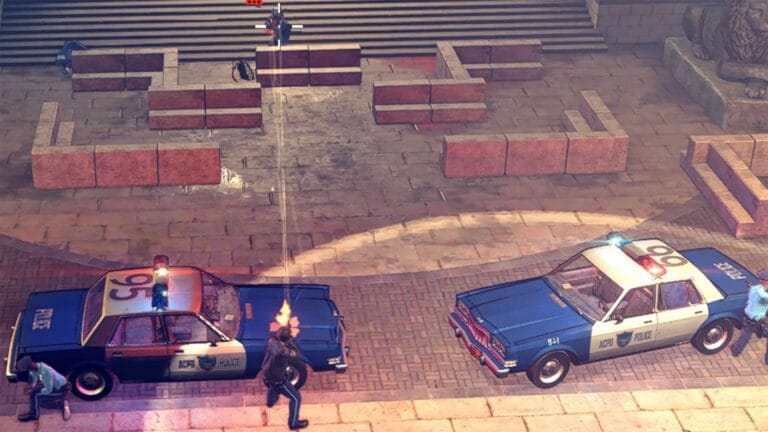The Precinct! You have the right to download just 3.5 GB of data and have fun! The Precinct is a small game with soul about playing cops and robbers, this time from the perspective of a rookie cop in the 1980s in a fictional version of New York City. If you want to check out the game yourself then click here – you can download The Precinct game for free.
The possibility of playing a criminal without any consequences is a much more popular theme in games, nevertheless examples showing what it’s like to stand on the side of the law are also not lacking, starting with the Police Quest series from the golden era of adventure games.
In many cases, developers opted for pure action, as in Max Payne, the SWAT series or Battlefield: Hardline. Slightly less frequently, we could get a sneak peek at detective work (L.A. Noire, Disco Elysium) or take on the role of a mere “curbside man” patrolling the streets.
The latter option appeared in the warmly received Polish production Beat Cop, and the just debuting The Precinct is nothing more than Beat Cop, in which the click adventure has been replaced with spectacular action and mechanics straight out of GTA: Chinatown Wars.
Everything here is spiced up with lovely graphics and an even better soundtrack – as long as you like synthwave and the 80s, because it’s exactly these atmospheres that pour out of the monitor. The game didn’t lack a plot full of clichéd but very fitting themes from any police movie, dynamic chases with highway cruisers and covershooter shootouts.

Hill Street Post
In The Precinct, we play Nick Cordell, a young police officer just out of the academy, who finds himself in the eponymous precinct in the fictional city of Averno, modeled on New York in the early 1980s. As a rookie, we are mainly involved in patrolling the streets, but we also happen to accompany detectives in actions against organized gangs, as well as participate in the investigation of a serial killer. After all, our protagonist has a certain “reputation”, or perhaps a burden – he is the son of a distinguished police officer killed in the line of duty for this post.
The plot, purposely steeped in the stiff motifs of any cop movie, generally booms at the very end. Before that, it’s mainly a backdrop for routine patrols. Here we have a list of the most wanted people from two rival gangs, and by performing daily activities, we randomly collect evidence of crimes. When we collect the required number of them to incriminate a particular gangster, we go to the action, i.e. some larger shootout enriched with rooftop and car chases.
So it’s nothing outstanding, especially since the cutscenes take the form of more of a radio play – it’s more of a sort of driving motive to pass more patrols. A little variety in the story is provided by a side plot, in which we visit the sites of the serial killer’s elaborate crimes, and the ending turns out to be better than expected. In any case, in The Precinct you don’t play for the story, but for the action straight out of the first and second GTAs – only that this time we act as law enforcement officers.
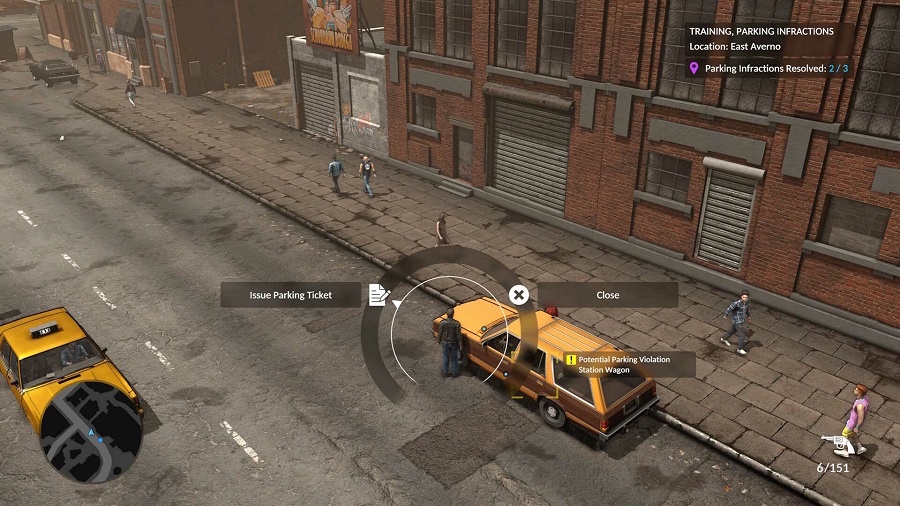
Patrols in the neighborhood
And the developers have combined in an interesting way the routine activities belonging to the duties of a police officer with elements of dynamic action. Each day, which somewhat resembles a single turn, we have to “do” our shift at the district, i.e. a patrol, during which we respond to operator’s calls and catch criminals red-handed.
We can choose one of the proposed patrols, or we can customize every element of it ourselves: the neighborhood, the movement (on foot, by police car or by helicopter) and the types of offenses (from parking fines, hunting down traffic pirates or vandals, to catching drug dealers, burglars and armed robberies).
On the district, everything takes place dynamically, and of course it can happen that while checking parking meters we come across a robbery in broad daylight, fleeing thieves or a shootout between gangs. We’ll quickly learn that we can’t fix the world on our own – we won’t have time to respond to some calls, and if there are more suspects, someone may escape us. Although we are accompanied by a partner, but his effectiveness sometimes varies.
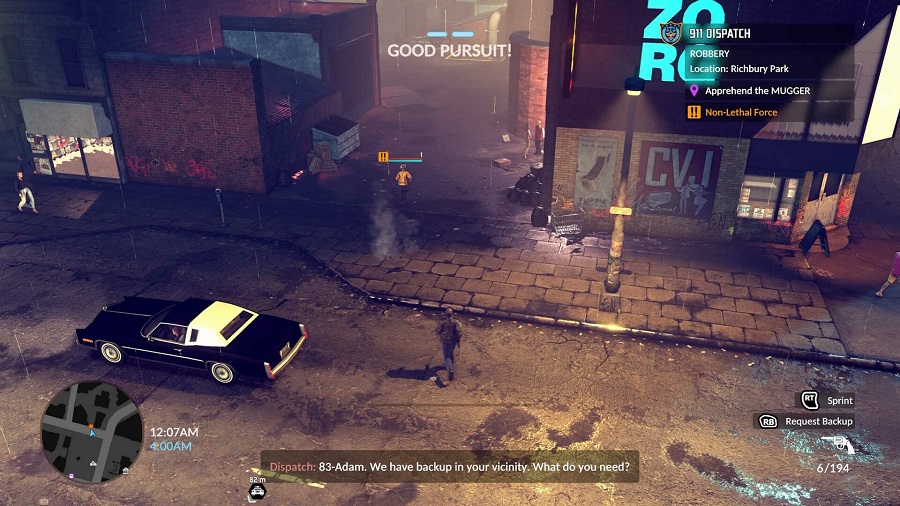
In the course of arrests, this greatest routine is evident. Each suspect must be identified, searched, read his Miranda rights if he is to be arrested, and the type of offense must be matched.
Vandals and litterers can be fined, others are arrested and either escorted to the station themselves or another patrol is called in. And so from intervention to intervention – until the end of the shift. We earn experience points for actions done well, and we lose XP for bad decisions, improper prosecutions, or arresting innocent bystanders.
Here I have the only reservation about the very symbolic consequences of our mistakes – failing to read the laws, a mismatched paragraph or even arresting an innocent person only end up with a deduction of a few XP points, which is practically not felt. I would have preferred more substantial penalties for notorious rule-breaking, such as being temporarily delegated solely to writing out fines on foot, or dropping a level or not having access to unlocked items. Indeed, there is something of a progression system here: for consecutive levels hammered in, you gain access to new types of police cars and weapons, and you decide for yourself to unlock perks such as a larger health and stamina bar, a larger supply of ammunition and new types of support.
You have the right to remain silent, and anything you say….
This routine of arrests is, first of all, very consistent with the concept of the game, in which we play the role of a rookie police officer, and secondly – almost every arrest is preceded by total random behavior of criminals. Just like in real life, you never know how the person being arrested will react. When chasing someone on foot, we have to keep an eye on the rapidly depleting stamina, throw ourselves at them with a pike, and mash a button in the QTE if the detainee decides to wrestle with us. You also have to keep an eye on what kind of weapons you can use. Some delinquents can be stopped by just knocking them to the ground, others with a stun gun, and only in a few cases are you allowed to start shooting.
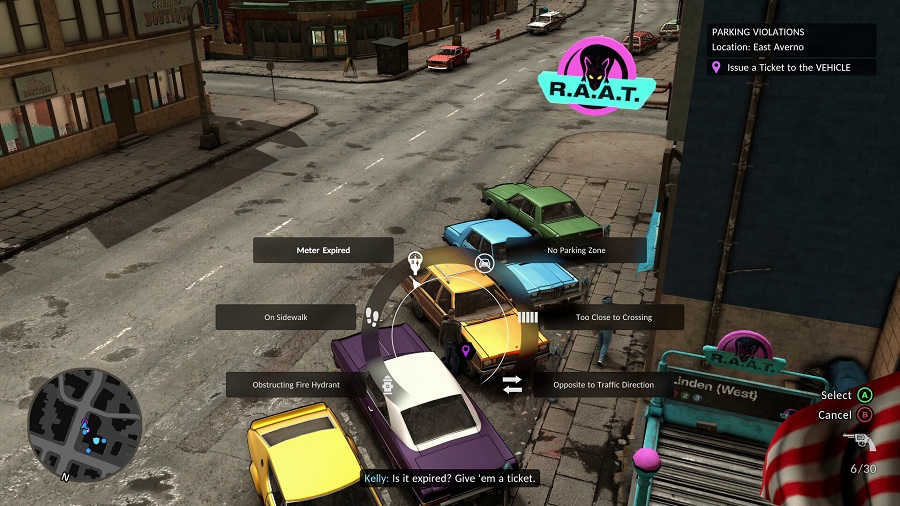
The shooting sequences, however, are merely OK. On the plus side, I credit the system of crouching behind cover, as in a standard cover shooter, and the choice of several weapons we can carry with us. But with the camera showing the action from above, even more distant than in Midnight Fight Express, they are neither spectacular nor particularly engaging, and boil down to pointing the cursor at the target. Fortunately, exchanges of gunfire occur much less frequently than car chases, and it is in this field that The Precinct shines the strongest.
Master steering wheel chases
Where to begin… First, we drive these big American road cruisers that rock at every turn due to the soft suspension. Secondly, the cars have a great model of destruction: the body bends, the hoods and bumpers fall off, and when the car enters a spike spread, it sits on the rims and drags sheaves of sparks behind it. Well, and finally, the handling model turns out to be quite demanding. Driving fast so as not to land on a lamppost and fall off the road requires a lot of feeling. And the opponents behind the wheel suddenly gain a lot of savvy: they can turn abruptly into tight corners, maneuver through streets, brake and turn around in front of spikes or roadblocks.
All this is accompanied by a spectacular model of environmental destruction – fences and barriers shatter, water gushes out of mowed hydrants, and pedestrians dodge cars like in Driver: San Francisco. As a result, there are no frustrating moments where our car would stop on every pole, or carnage among pedestrians. An additional attraction is the system of calling for support – over the radio we can request additional radio cars, a roadblock, a helicopter, a SWAT van, a spike, officers in case of a foot chase. All this creates a capital cinematic atmosphere, when several police cars with howling sirens chase a delinquent in a mustang or other muscle car, announcements are heard chirping on the police radio, mowed lampposts are toppling, and the streets are jammed with wrecked cars.
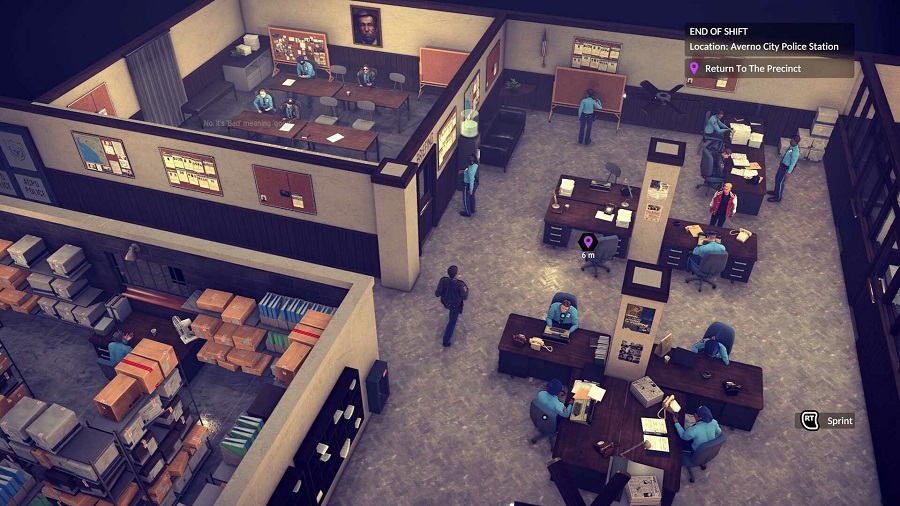
Driving is accompanied by mechanics familiar from GTA, such as the option to “borrow” any car in the city, including with a driver inside, repairing barely drivable wrecks by going through a garage, or a classic: blocked bridges that hide access to other neighborhoods. With all these chases on foot and behind the wheel, helicopter patrols are such a mute option – because we mainly watch the events below then and send out various types of support.
Mr. Authority, it ran amok….
I mentioned the random behavior of the suspects, and this is where The Precinct manages to strongly surprise, because only a small part of the events is oscripted. For example, a gangster during a shootout can simply stand and surrender, and a graffiti artist can start fleeing – first on foot, and then steal a car and drive away with a squeal of tires. Once, when checking documents, the delinquent threw himself into flight, but was unlucky because he ran under an oncoming car. Another time it was me who was hit while crossing the lanes. The lady behind the wheel, after pulling her out of the car, began to blow, earlier dropping a text that I had arrested her brother! It happened more than once that the suspect, fleeing, tried to hide in garbage cans!
It’s the details that count!
You can’t get away from comparisons with the early installments of GTA, but one more game came to mind for me while going through The Precinct – the first part of Settlers. Back then, we marveled at what craftsmanship and how convincingly all animations of working human beings, consisting of just a few pixels, were made. It’s the same here – the vehicles and characters are relatively small, but the animations that accompany them – excellent!
These include the destruction model of the vehicles, but also such details as the sequence of knocking down a suspect and handcuffing him, jumping into a trash can, sliding over the hood of a car – each such action looks smooth and realistic, even though on the monitor all the action is no bigger than a fingernail.

Averno City itself also looks very good. It is appropriately “dirty” and mired in suspicious areas, with a few more representative places. You can see life there, passersby busy with their own affairs. It is also gratifying that the results of our actions do not disappear from the map until the end of the shift – if we blocked the street with a car or left a pile of wrecks after a chase, they will be there all the time preventing traffic.
About the music I already mentioned – it is absolutely sensational! As for the Polish subtitles – I have somewhat mixed feelings. On the one hand, the translators showed quite a lot of creativity in translating some sayings, on the other hand, with some idioms it looks as if the context is a bit misunderstood. The atmosphere is also lost a bit in the Polish version, as phrases like “chew rubble” fit American gangsters from the 1980s on average, and intentional references to movies, like “Here’s Johnny!” are also lost.
Technically, the game performs well, although a little exaggerated, in my opinion, with the amount of reflections during the rain. The city then looks like one big mirror. There are also occasional animation clipping and random glyphs. However, these are mainly due to the dynamic development of the action, such as when several cars form a pile of wrecks during a chase, and the suspect then decides to get out and surrender. He forcefully stands on top of the wreckage and no interaction can be initiated with him.

A small game with a big soul
After completing the main story thread (there’s more than one ending!), one gets the impression that the game only picks up the pace in the final missions and in the serial killer thread, in which various scripted ideas for the course of the plot have been added – in my eyes, this is not a flaw, rather the potential for a possible sequel, in which Nick Cordell Jr. could already be promoted to detective. Routine patrols and routine arrests fit the role of a mere “beat cop” as much as possible, and there’s plenty of fun to be had in simply “rocking” a van around town while listening to great synthwave – as in any installment of Grand Theft Auto.
If only we accept the fact that we don’t play the role of John McClane’s super cop, but just an ordinary uniformed man patrolling the streets, which involves a certain routine and almost turn-based repetition of many activities, we get a capital little game that offers a lot of fun.
Hardly a game that will sometimes surprise us with some random, unscripted events, as well as references and easter eggs from many movies and TV series from the 1980s. After the news of the delay of “six” such a mini-GTA in the classic style and with the hero standing on the side of the law can be a nice sweetener to wait for the release. Small game, big soul, not to be missed this year!
